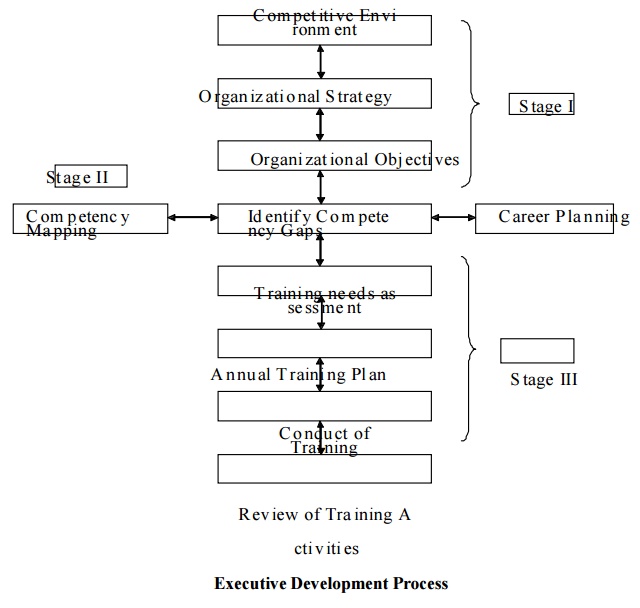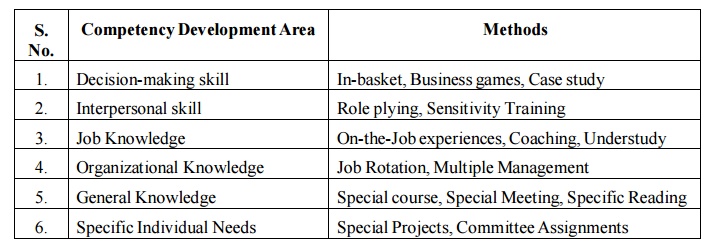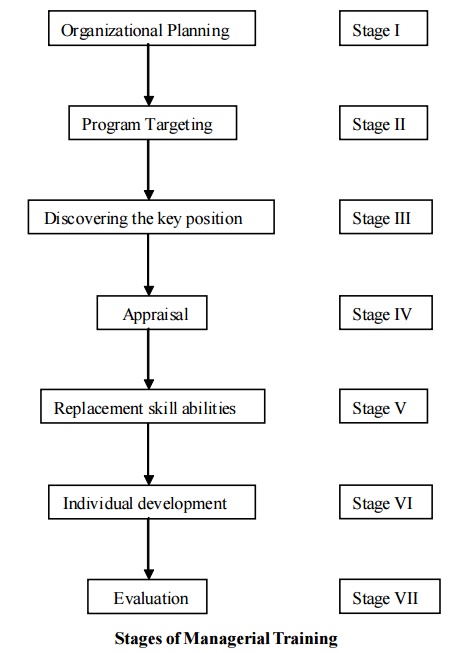Chapter: Business Science : Human Resource Management : Training and Executive Development
Executive Development
Executive Development:
1 Factors Influencing Executive Development
2 Factors InfluencingExecutive Development
3 Process
4 The Process of Executive Development
5 Evaluation of Executive Development
It is also known as ‗management development‘ or
‗executive development‘. It is one of the fastest- developing areas in
personnel. It is realized that an effective management team may be as important
to the survival of an organization as any tangible item on the balance sheet.
Interest in management development is great partly due to the shortage of
well-trained managers. Executive development or management development is a
systematic process of learning and growth by which managerial personnel gain
and apply knowledge, skills, attitudes and insights to manage the work in their
organization effectively and efficiently.
The
program of executive development aims at achieving following purposes: -
To
sustain good performance of managers throughout their careers by exploiting
their full potential. To understand economic, technical, and institutional
forces in order to solve business problems. To acquire knowledge about problems
of human resources.
To think
through problems this may confront the organization now or in the future. To
develop responsible leaders.
To
inculcate knowledge of human motivation and human relationships.
To increase proficiency in management techniques
such as work study, inventory control, operations research and quality control.
Johnson and Sorcher write, ―Management
development focuses on developing in a systematic manner, the knowledge base, attitudes, basic skills, interpersonal skills
and technical skills of the managerial cadre.‖
According to Flippo ―executive
development includes the process by which managers and executives acquire not only skills and competency
in their present job but also capabilities for future managerial tasks of
increasing difficulty and scope.‖
The
characteristics of executive development are as following: -
Executive
development is a planned and organized process of learning. It is an ongoing
and never ending exercise.
Executive
development is a long term process as managerial skills cannot be developed
overnight. It aims at preparing managers for managers.
Today, it
is the growth that makes one person stay at the company. The opportunity and
challenges iswhat keeps a person satisfied and charmed with his job. Companies
have understood this fact and therefore are forming policies and procedures to
develop their employees.
Executive
development Program (EDP) is one such program. With Human resource making a
move from a welfare department to a strategic partner, more and more companies
are undertaking this program. We at Career Solutions provide you the
opportunity of developing a specific EDP for your company. There are four major
steps to be covered during the EDP-
1)
Problem
Assessment: the experts along with the concerned employees and
CEO shall begin with an assessment
of the company‘s current problem and owner‘s plans of the future.
2)
Management
Audit and Appraisal: there shall be regular feedback sessions to check
as to whether we are reaching where
we are supposed to reach.
3)
Analysis
of Development Needs: here the problem that has been uncovered shall be
tried to and remedied via a
development program.
4)
Identify
Replacement Needs: the assessment may uncover a need to recruit and
select new management talent. The
format of EDP will vary with company‘s size and nature of operation so as to
provide optimum result.
1 Importance and Factors
Influencing Executive Development
Executive
development is more future oriented. It is more concerned with education than
is employee training. In today‘s competitive environment, an organization has
to be concerned about the development of supervisors, middle level managers and
top-level executive.
Executive
development is important for the following reasons: -
Executive
development programmes are required to train and develop professional managers.
It helps managers to develop skills to face cut throat competition.
It
enables managers to face problems related to technology and institution. It
helps in developing better relations with the labors.
Executives need training and education to
understand and adjust to changes in socio-economic changes.
Executive
development is required to broader the outlook of managers.
2 Factors Influencing Executive Development
A host of
factors influencing the executive development processes in organizations are as
follows:-
Failure
to train the managers will lead to ineffective and inefficient managers who
negatively affect the organization‘s performance.
In the absence of training and developmental
avenues, the performing managers may get de-motivated and frustrated in leading
the organizations. This would lead to severe losses for the organization in
financial parameters, in terms of the cost of recruiting and training the new
incumbent.
The organizational performance may be affected by
the loss of market shares, lower sales, reduced profitability, etc.
The absence/ shortage of trained and skilled
managers make it important for the organizations to have appropriate retention
strategies. Training and development is being used by organizations as a part
of their retention strategy.
The competitive pressures make it necessary for
organizations to continuously roll out new products and services, and also
maintain the quality of the existing ones. The training and development of
managers would help them in developing the competencies in these areas.
The competitive environment is making it imperative
for the organizations to continuously restructure and re-engineer, and to
embark upon these processes, it is essential for the organizations to train the
managers for the new scenarios.
3 Process
Contemporary
organizations have realized the importance of human capital and increasingly
finding its necessary to continuously train and develop human resources. The
training and development needs of the employees cannot be looked at in
isolation; any proactive organization has to view the individual training needs
in the overall organizational context. The training and development processes
are not longer adjunct to other departments but have become a part of
organizational strategy and one of the key organizational objectives. The
process of arriving at the development needs of the executives can be
comprehensively viewed through the process given in Fig.-

4 The Process of Executive Development
Stage I: In the
Stage I, at the macro level, there are three key elements are considered as
competitive advantage,
organizational strategy and organizational objectives. The analysis of
competitive environment helps the organization to decide its competitive
positioning in the market place, based on which the organizational strategy is
drawn out in an attempt to transform or reposition of the organization. The
macro view is broken down into specific organizational objectives for further
dissemination to functional/ departmental, and individual level.
Stage II: This
stage is most important and crucial phase of executive development process.
This stage deals analysis on the
competency mapping, identification of competency gap and career planning. In
the competency stage which helps to capture the competencies of all the
employees of the organization which includes the capacities of the management
also. In the second stage, the organizational requirements and competency gap
to be analyzed. In the third phase, this deals with identifying and verifying
the organizational needs, individual growth and along with career planning of
the executives.
Stage III: This
stage is consisting of three levels. The first level of this stage deals with
the activities involving training
need assessment of individuals and of all employees based on which Annual
Training Plan (ATP) is drawn. Based on the annual training plan the employees
are chosen to expose to either corporate training program, for internal
training programs and external organizations. While deciding the venue and
types and nature of the training program the personnel department and training
facilitator should consider the various issues like no of executives, cost,
outsourcing and availability of technical expertise in the organizations. In
case of organizational development related exercises, the combination of
internal and external training programs should be arrange for the all employee
of the organization.
Though
the money, infrastructure and finally the manpower to be utilized in the whole
process keeping into this, the top management has to take decision in this
regard. The training department, management and HR Department should work in
union. It is a collective phenomenon, which is mostly initiatives, motives of
the top management. If entire process of executive development is mostly
determined by its efficacyand its effectiveness.
Apart
from this the process of executive development can be defined in several other
ways with slight difference.
The
process of executive development is as follows:
1. Analysis of Development Needs: First of
all the present and future development needs of the organization are ascertained. It is necessary to determine how
many and what type of executives are required to meet the present and future
needs of the enterprise.
2. Appraisal of the Present Managerial Talent: A
qualitative assessment of the existing executives is made to determine the type of executive talent available within
the organization.
3. Planning Individual Development Programmes: Each one
of us has a unique set of physical, intellectual
and emotional characteristics. Therefore, development plan should be
tailor-made for each individual.
4. Establishing Training and Development Programme: The HR
department prepares comprehensive
and well conceived programmes.
5. Evaluating Developing Programs: Considerable
money, time and efforts are spent on executive development programmes. It is therefore natural to find out to
what extent the programme‘s objective has been achieved.
5 Evaluation of Executive Development
In the
competition scenario, where the focus is on efficiency and profitability and
the return on investment (ROI) on all the activities of the organization,
executive development cannot be an exception to the phenomenon. The evaluation
of the process assumes importance from the following perspectives:
Improving
the quality of the training and development process. Improving the efficiency
and competency of the trainers.
Making
improvements in the system to make it more responsive and realistic. Aligning
the training activities to the organizational objectives.
Building
the cost implications of the training into the organizational budget.
Evaluating
the ROI on account of training and development to justify further investments.
Changing the perception of the management on
training as expenditure to more as an investment for the future growth of the
organization.
The
levels of evaluation include the reaction level, immediate level, intermediate
level, and ultimate level. For the purpose of evaluation, it is essential to
collect the data for which there should be appropriate measures for data
collection, both during the course of the training programme and after the
training programme. Some of the methods being used by experts are self-complete
questionnaires, interviews, observations, and desk research. The desk research
involves low cost and less amount of time.
6 Methods of Executive
Development
Management
development programs help in acquiring and developing managerial skill and
knowledge. A Varity of methods of management development have come into
prominence these days. Different types of techniques are used to acquire and
develop various types of managerial skill and knowledge as given in the table
below:

Competency Development Area
1. Decision-making skill
2. Interpersonal skill
3. Job Knowledge
4. Organizational Knowledge
5. General Knowledge
6. Specific Individual Needs
Methods
1.
In-basket, Business games, Case study
2. Role
plying, Sensitivity Training
3.
On-the-Job experiences, Coaching, Understudy
4. Job
Rotation, Multiple Management
5.
Special course, Special Meeting, Specific Reading
6.
Special Projects, Committee Assignments
Managerial Training / Management
development: The following diagram shows the stages involved in
the managerial training.

Stages of Managerial Training
In all
above stages, we should satisfy the following essential aspects in order to
make the programmes a success:
1. Policy
decisions
2. Acceptance
3. Appreciation
4. Support
5. Conductive
atmosphere
6. Strong
urge for learning
7. Participation
8. Identification
of strength and weakness
9. Involvement
10.
Self-development
A number
of executive development methods are available. Generally these methods are
used in combination of two or more.
The
various techniques of executive development may be classified into two broad
categories: -
1. On the Job Techniques: It is
delivered to employees while they perform their regular jobs. In this way, they do not lose time while they
are learning. After a plan is developed for what should be taught, employees
should be informed of the details. A time-table should be established with
periodic evaluations to inform employees about their progress. On-the-job
techniques include orientations, job instruction training, apprenticeships,
internships and assistantships, job rotation and coaching. It consists of: -
Coaching-Coaching
is a one-to-one relationship between trainees and supervisors which offers workers continued guidance and
feedback on how well they are handling their tasks. The coach assigns the task,
monitors the trainee behavior, and provides reinforcement and feedback.
Coaching is commonly used for all kinds of trainees, from unskilled to
managerial position. This method is critically depends on the quality of the
coach.
Under
Study- An understudy may be assistant to someone or special assistant to some supervisory or executive positions. He
learns by experience, observation, guidance and coaching.
Position
Rotation-This involves the movement of the trainee from one job to another. This
helps him to have a general
understanding of how the organization functions. Apart from releasing boredom,
Job rotation allows workers to build rapport with a wide range of individuals
within the organization, facilitating future cooperation among various
departments. Such cross-trained personnel offer a great deal of flexibility for
organizations when transfers, promotions or replacement become inevitable.
Multiple
Management- It provides knowledge about the organization to the junior and middle managerial personnel. Here the members
are exposed to all types of the decision taken at higher level.
2.Off-the-Job
Technique: It consists of :
Lectures- It is a
traditional and direct method of instruction. The instructor organizes the material and gives it to a group of
trainees in the form of a talk. To be effective, the lecture must motivate and
create interest among the trainees. An advantage of this method is that it is
direct and can be used for a large group of trainees. The major limitation of
this method is that it does not providefor the transfer of training
effectively.
Case
Studies- It presents the trainees with a written description of a business or organizational problem. The object of
the case method is to teach the trainees how to analyze information, generate
alternative decisions, and evaluate the alternatives. Cases can be analyzed by
individuals or small groups. Feedback and reinforcement are provided through
oral discussion or written comments from the instructor.
Group
Discussions- This method is a direct discussion on a specific
topic conducted with a relatively
small group of trainees. This method is useful for teaching and exploring
difficult conceptual materials, and for changing attitudes and opinions. It
provides opportunity for feedback, reinforcement practice, motivation, and
transfer, largely due to the active interchange of ideas between the
participants.
Role
Playing- In most of role-playing assignments, each of the student takes the role
of a person affected by an issues on
human life and effect the human activities all around us from the perspective
of that person.
Management Games-
Verities of business and management games have been devised and are being used with the varying degree
of success in the developing programmes. A management game is classroom
exercise in which a number of team of trainees competes against each other to
achieve certain objectives.
Sensitivity
Training- It has been successfully employed by behavioral scientists over the past thirty years. Sensitivity to the
circumstances and feeling of others is the cornerstone of human relationships.
It is important to note that sensitivity is not just an emotion; it must
express itself in actions as well, especially when people we know are
experiencing pain and difficulties.
Benefits:
·
Increased job satisfaction and morale among
employees
·
Increased employee motivation
·
Increased efficiencies in processes, resulting in
financial gain
·
Increased capacity to adopt new technologies and
methods
·
Increased innovation in strategies and products
·
Reduced employee turnover
·
Enhanced company image, e.g., conducting ethics
training (not a good reason for ethics training!)
·
Risk management, e.g., training about sexual
harassment, diversity training
Related Topics